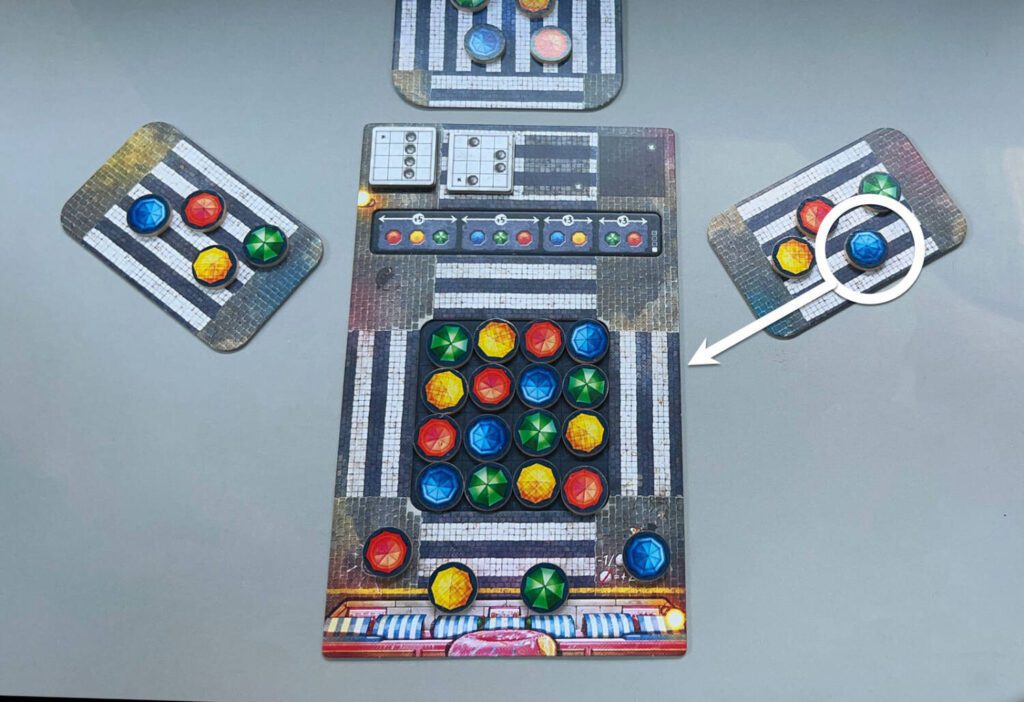Disclosure: Meeple Mountain received a free copy of this product in exchange for an honest, unbiased review. This review is not intended to be an endorsement.

Umbrella, by Flavien Dauphin and Benoit Turpin, published by Lumberjacks Studio and Pandasaurus Games, is a simple, elegant game that has recently earned a place on my abstract shelf. Let’s see if it lands on yours as well.
The concept is easy enough: you’re trying to rearrange your 4×4 field of colored umbrellas to match the patterns on one of your scoring tiles. Do so, and you’ll place one of the limited number of scoring tokens on your player board. When someone has claimed the last token, the game ends. Whoever has the most points wins.
Of course, the rules make doing so something of a challenge, so let me explain how to play Umbrella.
Falling On My Head Like a Memory
Each player has a board whose center, recessed area, is a 4×4 grid. You’ll place wooden discs with colored umbrellas on the matching, pre-printed spaces on your board. Above this area is a long open space where you’ll place one of the narrow scoring tiles. Players will also receive four square tiles with patterns on a 4×4 grid that matches your umbrella playing area. You’ll place these in two piles, one each on the two leftmost spaces, making sure the asterisks on the tiles match the orientation of the asterisks pre-printed on the playing board.
You’ll also have a common board in the center of the table, along with smaller boards that sit to the right and left of each player. These boards each get four umbrellas each, one per color. Then, all players get an additional set that they place at the bottom of their player board.
I Am Standing Up at the Water’s Edge in My Dream
Turns involve moving your umbrellas, side-to-side or up and down, to have one color match the pattern on one of your scoring tiles. To do so, you’ll be taking a single umbrella from one of the four areas external to your recessed playing board and slide it in a straight line into your central area. This will mean, of course, you’ll be pushing out the umbrella at the end of that row. You’ll move that umbrella to the external board in the same direction.
To illustrate, let’s say you wanted to shift your second row over one to the left. To do so, you’ll take an available umbrella from the external board to your right. You’ll set that to the right edge of the second row, then slide it onto your playing area. This will push the leftmost umbrella in that row out of the row. The just-removed umbrella follows its leftward movement and gets placed on the external board to your left.



Similarly, if you want to move a column up, you’ll take one of your umbrellas from the bottom of your player board and use it to push the column upward. The ejected umbrella continues its forward movement onto the common external board at the center of the table.
After scoring a pattern tile, you’ll hand it to the player on your left. That player must place it on their board immediately, but they get to choose which of the four slots (e.g., directional orientations) to place it in. (The tiles are double-sided. In a two-player game, you can choose which of the two sides of the tile your opponent will have to use.)

This sounds easy enough, but the reality is not so simple. There’s plenty of spatial thinking going on here, not only in trying to have your umbrellas match one of your scoring patterns, but also in trying to set yourself up to quickly match another scoring pattern.
I’m Laughing at Clouds
You’ll want to score quickly due to the limited number of scoring tokens. For instance, in a two player game (with 20 scoring possibilities between the players) there are only 11 tokens available. A three player game (with 30 scoring possibilities) only sees 17 tokens.
For the first two scoring options in the game, the scoring tile is divided into sections, each with two or three uniquely colored umbrellas. When you match a pattern with, say, a red set of umbrellas on your board, you’ll place a scoring token on a red umbrella on the scoring tile. Scoring all different colored umbrellas in a group will get you extra points—and in this low-scoring game, those extra points are crucial.

You’ll also score an additional two points if, at the end of the game, you have no umbrellas at the bottom of your board. For every umbrella you have, you’ll lose a point.
I Only Wanted to See You Laughing
Umbrella is one of those games that just looks good on the table. The wooden discs are solid and the four colors of the umbrellas pop on the board. (Bonus: the artwork features unique designs on the umbrellas, making the game color-blind friendly.) With all the circles of color surrounding you, this is an easy game to fall for.
Aesthetics is one thing, but gameplay is what I’m concerned with. While the concept remains the same, my individual games have all felt different—even back-to-back games have never felt the same. And despite recognizing scoring tiles from previous games, the positions of my umbrellas have never been the same, making the scoring tile pattern a new challenge every time.
My games (both two and three players) have lasted between 20-30 minutes. They’re so short and intense that you probably won’t realize Umbrella is another multiplayer solitaire game. Then again, like me, you might not care.
Umbrella is easy to get to the table, easy to teach, and easy for me to recommend.












Add Comment